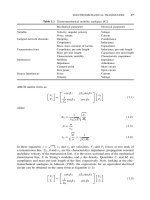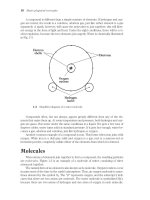Tài liệu Wimax - A Wireless Technology Revolution P2 pdf
Bạn đang xem bản rút gọn của tài liệu. Xem và tải ngay bản đầy đủ của tài liệu tại đây (1.87 MB, 10 trang )
12 n WiMAX: A Wireless Technology Revolution
supporting both Wi-Fi and WiMAX will be available for notebook computers,
PDAs, smart phones, and other handheld devices, thus enabling end users a seam-
less transition between 802.11-based LANs and 802.16-based MANs. What this
points out is that WiMAX actually can provide two forms of wireless service:
there is the NLoS, Wi-Fi sort of service, where a small antenna on your computer
connects to the tower. In this mode, WiMAX uses a lower frequency range, i.e.,
2 to 11 GHz (similar to Wi-Fi). Lower-wavelength transmissions are not as easily
disrupted by physical obstructions; they are better able to diffract, or bend, around
obstacles. ere is LoS service, where a fixed dish antenna points straight at the
WiMAX tower from a rooftop or pole. e LoS connection is stronger and more
stable, so it is able to send a lot of data with fewer errors. LoS transmissions use
higher frequencies, with ranges reaching a possible 66 GHz. At higher frequencies,
there is less interference and lots more bandwidth. Wi-Fi-style access will be limited
to a 4- to 6-mi radius (perhaps 25 sq mi or 65 sq km of coverage, which is similar
in range to a cell-phone zone). rough the stronger LoS antennas, the WiMAX
transmitting station would send data to WiMAX-enabled computers or routers set
up within the transmitter’s 30-mi radius (2800 sq mi or 9300 sq km of coverage).
is is what allows WiMAX to achieve its maximum range.
WiMAX operates on the same general principles as Wi-Fi — it sends data from
one computer to another via radio signals. A computer (either a desktop or a laptop)
equipped with WiMAX would receive data from the WiMAX transmitting station,
probably using encrypted data keys to prevent unauthorized users from stealing
access. e fastest Wi-Fi connection can transmit up to 54 Mbps under optimal
conditions. WiMAX should be able to handle up to 70 Mbps. Even once that
70 Mb is split up between several dozen businesses or a few hundred home users,
it will provide at least the equivalent of cable-modem transfer rates to each user.
e biggest difference is not speed; it is distance. WiMAX outdistances Wi-Fi by
miles. Wi-Fi’s range is about 100 ft (30 m). WiMAX will blanket a radius of 30 mi
(50 km) with wireless access. e increased range is due to the frequencies used and
the power of the transmitter. Of course, at that distance, terrain, weather, and large
buildings will act to reduce the maximum range in some circumstances, but the
potential is there to cover huge tracts of land.
802.16/HiperMAN Technology Specs
Based on IEEE 802.16 and ETSI HiperMAN, WiMAX selected the com-
mon mode of operation of these two standards — 256FFT OFDM.
Concentrated in 2- to 11-GHz WMAN, with the following set of features:
Service area range 50 km
NLoS
QoS designed in for voice/video, differentiated services
n
n
●
●
●
AU7059_C001.indd 12 9/7/07 11:36:54 AM
Introduction n 13
Very high spectrum utilization: 3.8 bit/Hz
Up to 280 Mbps per BS
Speed — 70 Mbps
Defines both the MAC and PHY layers and allows multiple PHY-layer
specifications
WiMAX is a cost-effective technology as it can be deployed quickly and effi-
ciently in regions that otherwise would not have broadband access. Although it has
great potential, a key decision with regard to spectrum choice is whether to use the
licensed or unlicensed spectrum (Figure 1.1). e use of the licensed spectrum has the
obvious advantage of providing protection against interference from other wireless
operators. e disadvantage is dealing with the licensing process. e use of the unli-
censed spectrum gives the wireless operator the advantage of being able to deploy
immediately but runs the risk of interference. With a large number of countries
tightly controlling the wireless spectrum, WiMAX needs all the encouragement
that the industry can provide it. Two primary bands are under consideration — the
licensed 3.5-GHz band and the unlicensed 5.8-GHz UNII band frequencies
(Table 1.6). Of these, the 3.5-GHz band seems to offer more promise, given the
●
●
●
n
3GPP bands
WiMAX approved
WiMAX proposed
880
960
1710
1885
2200
2305
2360
2400
2480
2500
2690
2700
2900
3300
3400
3600
5150
5350
5470
5725
5850
MHz
GSM 900 UMTS ISM band
MMDS band
BWA band UNII band
GSM 1800
New IMT-2000
spectrum
Licensed spectrum bands Unlicensed spectrum bands
Figure 1.1 WiMAX spectrum. (Courtesy of www.wimaxforum.org.)
Table 1.6 Key WiMAX Frequencies
Frequency (GHz) Allocation Countries Target Group
2.5 Licensed United States, Mexico,
Brazil, Southeast Asia,
and Korea (2.3 GHz)
Operators
3.5 Licensed Most of the countries Most of the
countries
5.8 Unlicensed or
light licensing
Most of the countries ISPs (grass root)
Source: From www.wimaxforum.org.
AU7059_C001.indd 13 9/7/07 11:37:14 AM
14 n WiMAX: A Wireless Technology Revolution
fact that the 5-GHz spectrum is fast approaching its limits in most technologies
and countries where it has been used.
Early products are likely to be aimed at network service providers (SPs) and
businesses, not consumers. It has the potential to enable millions more to have
wireless Internet connectivity, cheaply and easily. Proponents say that WiMAX
wireless coverage will be measured in square kilometers, although that of Wi-Fi is
measured in square meters. ese BSs will eventually cover an entire metropolitan
area, making that area into a WMAN and allowing true wireless mobility within
it, as opposed to hot-spot hopping required by Wi-Fi. Proponents of WiMAX are
hoping that the technology will eventually be used in notebook computers and
PDAs. True roaming cell-like wireless broadband, however, will require 802.16e.
True broadband for portable users, based on IEEE 802.16e, enables the creation of
a “CPE-less” broadband market, providing broadband connectivity for laptops and
PDAs with integrated WiMAX technology.
Governments globally are starting to prioritize broadband as a key political
objective for all citizens to overcome the “broadband gap,” also known as the
“digital divide.” In last-mile markets where traditional cable or copper/fiber infra-
structures are saturated, outdated, or simply out of reach, BWA technology fills the
void admirably, providing highly efficient and cost-effective access services for a
large number of subscribers who would otherwise be left out of the loop in devel-
oped markets. e growing demand for broadband services on a global scale is clear
and uncontestable. Businesses, public institutions, and private users regard it as an
enabling technology, and it has become a given requirement for delivering commu-
nications services in the information age. e introduction of WMAN standards
(802.16 and HiperMAN), and the guidelines set forth by the WiMAX Forum to
ensure its success, will do much to encourage the growth of broadband wireless
markets everywhere, benefiting everyone in the delivery chain — from equipment
vendors to carriers to end users. As the wireless industry’s most experienced solu-
tions provider, Alvarion has a long and impressive record of commitment to devel-
oping and introducing standardized protocols. e buzz on WiMAX these days is
electric. Internationally, it seems that WiMAX is already poised to take off as it is
a hungrily awaited product.
Numerous countries have aggressive service providers fielding broadband ser-
vices largely in the 3.5-GHz spectrum. e results of various investigations show
that there is a positive business case for operators who want to add services and
applications comparable to other existing broadband technologies (e.g., cable or
DSL) for both high-volume residential and high-revenue business customers in
greenfield and overlay scenarios, and also want to address the problems associated
with the digital divide (e.g., limited range and, hence, limited penetration in under-
served areas). e emerging markets can also benefit from the WiMAX technology,
particularly those operators who are interested in using WiMAX for low-cost voice
transport and delivery, which has been very difficult with proprietary solutions.
Overall, markets without any fixed infrastructure pose the greatest opportunities.
AU7059_C001.indd 14 9/7/07 11:37:14 AM
Introduction n 15
ey benefit from the absence of steep installation or rental costs because no out-
side-plant costs are necessary for copper/fiber and scalable equipment, matching
the rollout to the acquired subscribers.
WiMAX seems new but, in many ways, it is nothing new at all. Much of the
technology has been around for several years. Several vendors had offered variations
of the current WiMAX flavor earlier — indeed they donated the seed technology
to the WiMAX Forum. However, these firms all built 802.11 proprietary systems.
Each fielded a Media Access Control (MAC) that offered specific improvements
over the Wi-Fi standard. What was missing among these numerous vendors was
interoperability. At its core, WiMAX is just such a standards initiative. Virtually
everyone agrees that broadband wireless is here to stay and that standardization
is essential. How quickly WiMAX gear is adopted will fuel expected price reduc-
tions. Having defined WiMAX in terms of its economic impact, there do remain
important technical and business considerations to examine. With the advent of
WiMAX, BWA is undergoing a dramatic change. What differentiates WiMAX
from earlier BWA developments is standardization. Current broadband wire-
less deployments are based on proprietary solutions in which each BWA vendor
custom-builds its solution, which adds time and cost to the process. Similar to
what has happened recently in the WLAN arena with Wi-Fi, WiMAX plans to
enforce standards compliance among vendor members. is compliance will result
in interoperability and ultimately plug-and-play products, the cost of which will
benefit from economies of scale and hence bring dramatic improvement to the
business case for the operator. WiMAX products are set to become the mainstream
broadband wireless platform. Although the overall number of subscriber lines is
quite small relative to DSL or cable, the dollar value is growing to the point where
even major carriers are beginning to pay close attention. It is not only the devel-
oped markets that can benefit from WiMAX. For emerging markets, operators
are interested in using WiMAX for low-cost voice transport and delivery, which
has been very difficult with proprietary solutions. As noted previously, the mar-
kets without any fixed infrastructure pose the greatest opportunities. Develop-
ments such as WiMAX chipsets embedded in laptops and other mobile devices
will lead to broadband portability and to a CPE-less business model, which makes
the case even more compelling for an operator because the user is subsidizing the
model.
e main problems with broadband access are that it is expensive and it does
not reach all areas. e main problem with Wi-Fi access is that hot spots are very
small, so coverage is sparse. WiMAX has the potential to do to broadband Internet
access what cell phones have done to phone access. In the same way that many peo-
ple have given up their “landlines” in favor of cell phones, WiMAX could replace
cable and DSL services, providing universal Internet access just about anywhere
you go. WiMAX will also be as painless as Wi-Fi — turning your computer on will
automatically connect you to the closest available WiMAX antenna. An important
aspect of the IEEE 802.16 is that it defines a MAC layer that supports multiple
AU7059_C001.indd 15 9/7/07 11:37:15 AM
16 n WiMAX: A Wireless Technology Revolution
physical layer (PHY) specifications. is is crucial to allow equipment makers to
differentiate their offerings. Enhancements to current and new technologies and
potentially new basic technologies incorporated into the PHY can be used. A con-
verging trend is the use of multimode and multiradio SoCs and system designs that
are harmonized through the use of common MAC, system management, roaming,
IMS, and other levels of the system. WiMAX may be described as a bold attempt at
forging many technologies to serve many needs across many spectrums. e MAC
is significantly different from that of Wi-Fi. In Wi-Fi, the MAC uses contention
access — all subscriber stations wishing to pass data through an access point are
competing for the AP’s attention on a random basis. is can cause distant nodes
from the AP to be repeatedly interrupted by less sensitive, closer nodes, greatly
reducing their throughput. By contrast, the 802.16 MAC is a scheduling MAC
where the subscriber station only has to compete once (for initial entry into the
network). After that, it is allocated a time slot by the BS. e time slot can enlarge
and constrict, but it remains assigned to the subscriber station, meaning that other
subscribers are not supposed to use it but take their turn. is scheduling algorithm
is stable under overload and oversubscription (unlike 802.11). It is also much more
bandwidth efficient. e scheduling algorithm also allows the BS to control QoS by
balancing the assignments among the needs of the subscriber stations.
BWA is being revolutionized by standardization. Operators can benefit from
interoperability and economies of scale of WiMAX equipment, which will dominate
the wireless technologies available on the market, with the first products becoming
available soon. Although operators have deployed broadband services to many sub-
scribers who are within reach of central office locations, there is still an untapped
market of subscribers who do not benefit from them. With WiMAX, operators are
being given the chance to extend their customer base to include these subscribers
using a highly efficient and cost-effective complementary access technology.
In emerging markets, operators will be able to capitalize on the benefits that are asso-
ciated with standardized equipment, such as economies of scale. WiMAX deploy-
ment will follow a two-stage development. Once mobility and broadband have
been combined in step two in the form of in integrated CPEs in 2006, WiMAX
will coexist alongside Universal Mobile Telecommunications System (UMTS).
Although wireless connectivity options have expanded rapidly in recent years,
wireless network access is available now only in limited physical areas. Internet and
intranet users need broadband access that extends over longer distances to more
locations. e WiMAX standard, developed to create certified standards-based
products from a wide range of vendors, enables system vendors to create many dif-
ferent types of products, including various configurations of BSs and customer
premise equipment. WiMAX supports a variety of wireless broadband connections:
In addition to supporting the 2- to 11-GHz frequency range, the 802.16d standard sup-
ports three PHYs. e mandatory PHY mode is 256-point FFT orthogonal frequency
modulation (OFDM). e other two PHY modes are single carrier (SC) and 2048
orthogonal frequency division multiple access (OFDMA) modes. e corresponding
AU7059_C001.indd 16 9/7/07 11:37:15 AM









